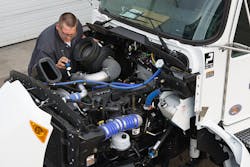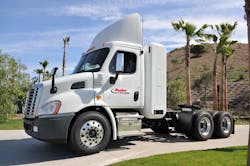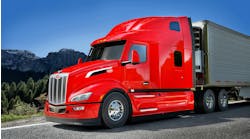When it comes to obtaining the best tractor-trailer fuel economy, there are lots of options available to fleets, e.g., smaller and lighter engines, low-rolling resistance tires, aerodynamic skirts and fairings. The list goes on and on. And fleets can also tailor whatever fuel economy package they pick to their specific application. For example, skipping fairings altogether and spec’ing small-block engines may be a better choice for fleets in short-haul, stop-and-go environments, while fairings and low-rolling resistance tires may be a better fit for motor carriers with vehicles that maintain a consistent highway speed above 60 mph.
Yet many leasing/rental companies don’t always have the luxury of completely “dialing in” a specific set of fuel efficiency specs, as many of their trucks and trailers get deployed among different applications within a fleet as well as different fleets altogether.
“It comes down to a couple of different categories,” Paul Rosa, senior vice president at Penske Truck Leasing, noted. “We have thousands of lease customers individually spec trucks for their specific needs—and there are a plethora of different ways to provide fuel savings for both the truck and trailer. But the trick is to balance things more in our rental fleet, between fuel economy and performance. Half of our [rental] customers want fuel efficiency and half want performance; that’s tough to balance.
“And we need to make three kinds of vehicles appealing—sleepers, day cabs with tandem rear axles, and day cabs with single rear axles,” he continued. “Remember, too, a large majority of our rental fleet is driven by lease contract customers, so we have to make our rental fleet conducive to what our lease customers want.”
Every year, Penske gives “careful thought” to the trucks and trailers it makes available for customers to drive. “We need to be sure they have a great experience,” Rosa explained. “We need to give them that balance between fuel economy, performance and comfort.”
Nic Signorini, director of supply management for the fleet management solutions division within Ryder System, noted that “all of our customers are looking at fuel economy because it’s a significant part of their operations costs.”
When the discussion turns to performance versus fuel economy, it usually comes down to packaging specs for specific customers in specific applications. But like Penske, Ryder tries to pursue what he dubbed a “balanced approach” in the rental fleet. “We don’t try to push the fuel economy envelope all the way,” Signorini explained. “We’re trying to support multiple applications” with one set of truck or tractor-trailer specs.
Thus, for sleeper-equipped tractors, there’s a need to be “conscious” of the over-the-road (OTR) long-haul environment—the need for aerodynamic packages, engines equipped for downspeeding, and automated manual transmissions (AMTs) that are now standard on Ryder’s equipment.
“What we try to do is offer the fuel economy benefits but be able to run in most applications with the desired performance,” Signorini said. “For example, if you are in pickup and delivery, with multiple stops, maybe topping out at 30 mph to 40 mph, you are not getting the benefit from aerodynamic packages.”
The rental arena is where Rosa said Penske “gets a good sense of user acceptance” regarding particular truck specs. Drivers and fleet managers also make suggestions concerning specs, recommending items such as wheel covers to improve the vehicle’s aerodynamic performance, tire pressure monitoring system technology, etc.
“We obviously evaluate those and others, but not everything has to be on every vehicle,” he emphasized. “The great news about technology today is that it produces data we can analyze, that can readily make available the details we need and our customers need to make proper [spec] recommendations.”
Still, Mike Willey, director of sales for PacLease, said lease and rental customers alike demand fuel economy “plain and simple” as a base requirement.
“Performance is balanced in, yes, but regardless of application— whether you are an off-road tanker or in over-the-road dry van operations—there is not a fleet out there that does not demand fuel economy,” he stressed.
Willey said that, in his opinion, optimizing fuel economy starts with the powertrain—tuning the engine, transmission, and rear axles into a “seamless unit”—and then working your way down toward more “ancillary” areas such as wheel closeouts, roof and side fairings, plus trailer tails, where applicable.
“Tires and wheels are toward the end because you have to be really cognizant of them versus the expected application,” he emphasized. “Low-rolling resistance tires are fine in OTR, but if you get into regional operations, you are scrubbing them a ton; there are a lot of tight corners. And tire failure is very expensive—fuel savings will be given up quickly if you are on the side of the road.”
With those general thoughts in mind, here’s how those three leasing/rental companies are putting fuel-efficient specs into their trucks and trailers.
PacLease
As a division of Paccar Corp., which owns Kenworth Truck Co. and Peterbilt Motors Co., Paccar Leasing, or PacLease as the firm is generally known, works hand-in-glove where possible with its fellow divisions to try and match specs to market demands as closely as possible.
“It’s not far-fetched to go to engineers on the Kenworth or Peterbilt side to spec [trucks] to demands of the customer. Their involvement becomes critical,” Willey explained. “We start with a Paccar engine, transmission, and axles combined together versus a ‘pieced together’ powertrain. That’s because they are designed to electronically talk to each other in peak demand situations.”
Paccar currently offers a proprietary 13-liter MX-13 and 11-liter MX-11 engine, and though the 11-liter model is “fairly new,” Willey said it is finding “great acceptance” in applications where weight reductions and extra fuel savings are needed, especially in LTL and local operations.
“Honestly, too, the AMT is widely accepted now,” he added, noting that Paccar’s proprietary 12-speed AMT (formally introduced last year) is built in partnership with Eaton Corp. “Like anything, it’s taken time to adapt to, but now it’s accepted. It is becoming a significantly tipped balance in terms of choosing AMTs versus manuals.”
Willey also explained that more aerodynamic packages are being spec’d than in the past. For example, Kenworth’s T680 tractor and Peterbilt’s Model 579 feature the new integrated UltraLoft sleeper berth for improved aerodynamics, among other things.
“Fuel economy is seeing more demand even for the regional haulers. They are looking mainly at weight savings to achieve fuel savings, because they have to be cognizant about potential damage to side skirts that may impact fuel savings,” he said. “So many factors in the leasing world deal with each application finding that right blend of fuel economy and performance.”
Penske Truck Leasing
For Class 8 sleeper tractors, Penske still starts with a 15-liter engine as a base spec, then downshifts to a 13-liter engine for both its tandem and single rear axle day cab tractors. “The 11-liter engine option is still so new, we haven’t spec’d many yet,” Rosa said.
Penske also transitioned to AMTS, making it the standard gearbox for its lease/rental fleet. “Few if any manuals are requested,” he said.
The company specs low rear axle ratios to maximize fuel efficiency on cruise control, especially for the“flat” regions of the United States, such as Texas and the Midwest plains. “We use direct drive to maintain a 62 mpg cruise speed in our lease fleet but shift to a higher cruise speed in our rental vehicles,” Rosa noted. “We’re trying in rental to set up a ‘blended vehicle’ for the customer—not too low of a rear axle ratio for downspeeding.”
Penske also favors the “vertically integrated” powertrain packages offered by Volvo Trucks North America (the I-Shift AMT mated to a D13 engine) and Daimler Trucks North America (which offers Detroit engines combined with its proprietary D12 AMT) along with Navistar models featuring the Cummins/Eaton engine and AMT combination.
“The integrated powertrain gives us an optimal setup for fuel economy and good performance,” Rosa explained. “Those can handle Rocky Mountain driving and heavy loads, but they also give us the best fuel economy. We get the best of both worlds.”
Other “small touches” Penske makes to its specs include aluminum wheels, predictive cruise control options, smaller fuel tanks, and more “aero packages,” which can deliver up to 3% in incremental fuel economy gains.
Another way Penske tries to improve energy efficiency without compromising performance is to continually update the fleet with newer models. “We’re getting out of six-year-old tractors and buying new units with aero packages,” Rosa said. “We’re buying the new Volvo VNL, Navistar LT, and Freightliner Cascadia models.”
Ryder System
From where Signorini sits, Ryder hasn’t experienced too much of an uptick in demand for 11-liter engines. “At least not enough yet,” he said.
“We certainly see the 13-liter being broadly adopted in day cabs. Sleepers are still 15-liter displacement; that is still more fuel efficient versus a 13-liter,” he continued. “And the reason for the 15-liter being so predominant is that so much development has gone into it. There’s been a lot of focus on generating more fuel efficiency first with the 15-liter. Then that permeates down to the smaller engines as well.”
Broadly speaking, Signorini said lower engine rpms are a fuel efficiency trend “that is continuing, as downsped engines with lower rpms certainly drive fuel economy gains. And AMTs on top of that make shifting easier.”
Without speaking to specific brand names, he said, generally, there are fuel economy advantages to integrated powertrains. “They just ‘speak’ together more effectively. It is an important piece of the fuel economy puzzle. So by integrating the two components [engine and transmission], significant benefits come from their interactions.”
Both lease and rental customers are going after weight as well, though weight savings don’t drive every spec’ing chosen, Signorini stressed.
For example, take wide-base tires. “We haven’t seen too much penetration by wide-base tires in the market,” he explained. “Some customers run them and while they have fuel economy benefits and offer weight savings, there are other considerations such as availability and the ability to replace breakdown. If it takes longer to find one in stock, then that’s a cost consideration that must be added into the spec’ing mix.”
For a period of time a few years ago, Signorini saw more movement to wide base, but now many customers are coming back to duals. “It’s also about residual value; here’s that total cost of ownership and what to do at the end of a vehicle’s life at resale.”
Still, “light-weighting” remains viewed as a viable fuel efficiency strategy, but he stressed that it “has to make sense” to form an overall cost perspective.
“Bulk haulers are more sensitive to weight; it helps them increase payloads as they ‘max out’ on GVW (gross vehicle weight),” Signorini continued. “That allows them to carry more payload with fewer trucks—and that factors into the equation.”
At the end of the day, though, especially for lease customers, it’s about looking at how many stops per day a truck or tractor-trailer makes, its monthly and annual mileage, its percentage in cruise/top gear, and the hill grade it drives that gives “true” visibility as to how that vehicle has to be configured.
“Obviously, when you are talking about a broad customer base like ours, we’ll see a little bit of everything. But generally speaking, the trend is to spec a truck for a particular situation,” he explained. “We need to be conscious of what the customer is trying to do. If we can tweak the vehicle up front to optimize it for their application, everybody wins.”






